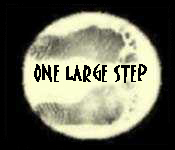The
Silence of Sasquatch
Toeing the
Dark Divide
Thus I fled ridiculous hairy creature torn
apart by poetry - crawling, whimpering,
streaming tears, across the world like a
two-headed beast...
Part-animal, part-human who can hypnotize, ventriloquise, make himself invisible.Dzuteh, Meh-teh, O-mah, Alma, Yeti, Ban Jhakri, Skunk Ape, Upslope Person...Sasquatch speaks but we do not hear: silence is not the absence of sound but the failure to hear.
In a clearing, he emerges as a trace of the enormous being we are when we are the missing link. Is Sasquatch our longing to retrieve an innocence lost when we learned how to slaughter or domesticate animals for food, magic, and anthropocentric love? Digging through the middens of human culture for discarded scraps of disquieting questions, Sasquatch emerges as an uncanny totem for what is most difficult to see but conceivably there.
Although the Dark Divide retains it's geography "in the middle of a diamond formed by Mounts Rainier, Adams, St. Helens, and Hood," in Washington and Oregon states, it is also the artificial divide between species that's addressed here.
Sasquatches discretely sense their death, thus transmit a culture. Yet it is not what it is to be one that motivates this project, but where they "cease to be subjects to become events." The ties that bind a species to another dwell in the liminal space in which Sasquatch may be found.
| When eyes
and ears tell us nothing of such things, how could anyone follow the path with mere footsteps? -Hsueh Ling-yün. |
This writer is "an experimental man (who thereby ceases to be a man in order to become an ape or a beetle, or a dog, or mouse, a becoming-animal...)" However, man or woman, before we can know what experimental means, we must already no longer recognize ourselves "as human in any finished or even vertical sense."
There is one famed and blurry movie, a plethora of footprints, some obvious hoaxes, volumes of tall tales tracked mainly in laymen circles. My plan is to draw on the habitat in which Sasquatch displaces those "dark, compelling presences that pose an ultimate choice between everything and nothing," balancing on the limen of the Dark/Divide.
Begin Here With:
"The instrument of the search will determine the nature of what is found, and the instrument is the human mind," with texts, paratexts, images, invaginations, |
 |
dreams, cryptozoology, |
My appreciation begins with Robert Michael Pyle, whose book, Where Bigfoot Walks: Crossing the Dark Divide, opened the territory for this project. As Bigfoot's range is worldwide, my gratitude extends to John Kielty Bell, England; Fatima Lasay, The Philippines; Regina CÚlia Pinto, Brazil; and Reiner Strasser, Germany. In Canada, literary critics Alan Bourassa and Pamela Gravestock kindly allowed me to quote from their respective work. Back in the USA: Professor Tracy Dillon of Portland State University, and scholars Michael Rothenberg, Anthony Chiavello, and Ralph H. Lutts. To psychologist James Hillman, Bigfoot investigator Autumn Williams, and digital artist Millie Niss. To Pamela Causgrove, for her opening invaluable resources to me. And to Kevin Campbell, for decades of friendship and insightful discussions.
Joel Weishaus
Portland, OR.
